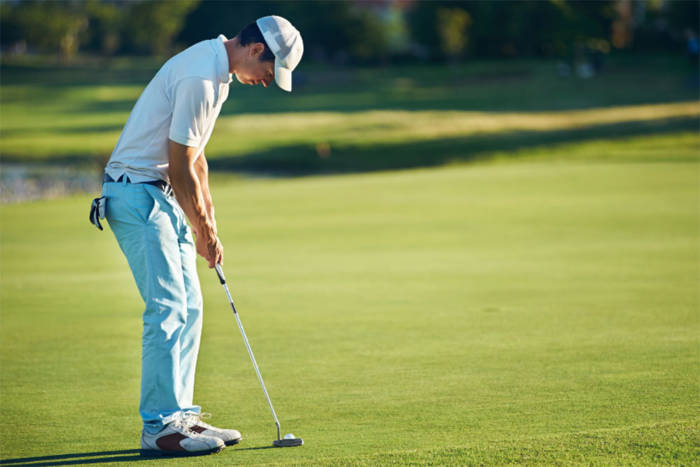How To Hit A Golf Ball
Golf can be one of the hardest sports to pick up. Most people won’t even make contact with the ball with their first attempt at a golf swing!
So how do you go from nothing to be able to hit a golf ball and enjoy a round of golf? Well, the short answer is it takes plenty of practice! And whilst every golfer is different, it helps to understand the basic fundamentals of the golf swing when you’re learning as a beginner.
So that’s why we put together this guide for beginners on how to hit a golf ball. We’ll cover the basics and key things to look out for at each stage of the swing. So if you want to improve your game, read on to find out more about perfecting your swing!

Golf swing basics
As a beginner before getting into the steps it takes to hit a golf ball, it’s important to understand some of the fundamentals to the golf swing.
Primarily, the golf swing should be designed to achieve three things:
- Power – apply enough power to hit the golf ball a certain distance and get the golf ball airborne
- Accuracy – it’s no good just being able to hit the golf ball a long way. After all, golf is a game that involves hitting the ball at a target (the flag), so the swing should produce a motion that results in some accuracy on where the golf ball will finish
- Consistency – we want the swing to be repeatbale again and again and thus as consistent as possible
In order to achieve this we need to think of the golf swing as a rotational action of the golf club that moves around the body in a spherical manner.
Most amateurs or newer golfers think that to hit the ball straight, you need an up and down the line action to help keep the golf club pointed always to the target. However, this isn’t correct. As the golf ball is positioned to the side of you, you need need to think of the swing as going around the body in an arc.
The video below helps explain this in more detail and why this is important.
Even for golfers who’ve played the game a long time, the swing can be a complex thing.
There are many different swing thoughts and advice you can find online, and it can leave you feeling a little bit like the diagram below!

The reality is, each golfer is different.
They have different heights, builds, strength, flexibility and hand-eye coordination. There’s no real “one size fits all” approach to the golf swing, that’s why it’s always recommended to have lessons from a PGA professional when you’re starting out.
However, if you want to learn how to hit a golf ball before taking things a little more serious, you can move onto the steps below which will give you the basics to a good golf shot.
The Complete Golf Swing Guide videos series from Rich Shiels also runs through each of the steps in more detail if you’re eager to learn more at any stage of the swing. We’ve included some of the videos from the series in the steps below. You can also check out some of our favourite golf YouTube channels to help you develop your knowledge of the game.
But for now, onto the steps of how to hit a golf ball.
Step 1: Establish your target line
First and foremost, you’ll want to know where you want the ball to go before you hit the shot. Without knowing this you can’t aim properly and as a result you won’t hit your best shot.
When picking your target, try to be as specific as possible. Instead of aiming down the line of the “trees behind the green”, pick out a specific tree, or even better a particular branch on that tree.
The more specific you are with your target, the more focussed you will be on that point and your margin for error will be reduced. If you aim for a specific branch and it doesn’t quite go directly at it, chances are you’ll be on target for the “trees behind the green” which is what you wanted in the first place.
Being specific with your target helps your hand-eye coordination throughout the swing and should give you the best chance of hitting a good shot.
Step 2: Prepare for your address position
Once you’ve established the direction in which you want to hit the ball, it’s time to get yourself set up for the shot.
When you address the ball, you’ll want to make sure the clubface, your feet, hips and shoulders are all parallel to the target line to give you the best chance of hitting a good shot.
The best way to do this, is to first place the club face behind the ball aiming at the target.
Once you’re happy with where the club is aiming, approach the golf ball and slightly flex your knees in front of your hips and bend your upper body towards the ball. Make sure you centre your weight over the balls of your feet, and let your arms hang down from your body – you don’t want to be “reaching” for the golf ball.
You’ll want your feet about should width apart with the lead foot (the one that’s closest to the target) to be pointed slightly towards the target – this will allow for maximum hip rotation.
Step 3: Get your grip
Grip the club normally, allowing your arms to hang straight down, and your hands in line with your chest.
For beginners, it’s best to opt for a neutral grip. This is where you place your lead hand towards the top of the club (about half an inch from the end of the club). Place your trail hand over your lead hand, making sure the palm sits over the lead hand’s thumb.
Check out our more detailed post on grips if you want to learn more about how best to hold a golf club.
Step 4: The takeaway
This is the first part of the backswing and is refers to the first 12-18 inches of backwards movement. This is a crucial stage as you can set yourself up for a great swing.
Begin to move your arms and shoulders backwards in one motion, keep your arms straight as your wrists begin to hinge.
Step 5: Backswing
As you continue backwards, resist the urge to bend your lead arm, instead bend your trail arm at the elbow. As your elbow bends, it’ll cause the club to naturally angle how it needs to.
Maintain your body position as you rotate through the swing with your hips and shoulders, avoiding swaying backwards or moving the body forwards.
And always swing within the confines of your flexibility and what feels comfortable for you, this may be different for each golfer – there’s no right or wrong answer!
Step 6: Downswing
This is the fastest step of all, as the speed you move here will determine how far and fast the ball will go.
From the top of the backswing and to begin the downswing, shift your weight towards your lead foot ever so slightly to guarantee you make contact with the ball before the ground.
From here, all you need to do is unwind the rotation and power that has been created on the backswing by turning your shoulders and hips back towards the target.
Keep your forearms relaxed, and try to let your body and torso control the swing rather than your arms.
Step 7: Follow through
After you’ve hit the ball, it’s important you follow through the motion. All your weight should be on your lead foot, with just the tips of your toes touching the ground on the other foot.
You should have enough balance to hold this position for 10 seconds as you watch your ball soar!
For a beginner, the best thought is that instead of hitting the ball, the golf ball gets in the way of the swing. This should promote a nice, smooth action which gives you the greatest chance of hitting a good shot.
Different Golf Swings
When you’re out on the golf course, you’ll be required to hit an array of different clubs to make different shots. Whether you’re using a driver, iron or putter, your swing will differ ever so slightly, so make sure you bear in mind the following tips.
Drive off the tee
Most of the time you’ll be using a driver to hit the ball off the tee. The goal is to use your driver to hit the ball as far down the fairway as possible to cover as much ground as possible during your first shot.
As the biggest and longest club in the bag, you’ll need to stand a little further away from the ball so that your arms still hang naturally down at address. Your swing will also need to come around the body a little more with the angle between the club and ground a little flatter than that of a wedge.
At address place the ball further forward in your stance (closer to your lead foot) to help promote a sweeping motion that the driver requires.
Chip
You’ll usually opt to “chip” the ball when you’re very close to the green. This is where your shot will change quite drastically as you’ll want the ball to spend more time on the ground than in the air.
Think of a chip as an abbreviated version of a full swing. Distance and rotation isn’t as key to a good chip shot (as you’re only trying to cover a small distance) so you can stand closer to the ball with a narrower stance to help give as much “feel” as possible, which is more important when in and around the green.
Pitch
A pitch shot is pretty similar to a chip, however, it requires a slightly different approach. If you’re not as close to the green, and need to hit the ball high over some rough or a bunker, then that’s when you’ll want to “pitch” the ball.
For a pitch shot, your stance will need to be somewhere between a chip and a full shot. You’ll also want to put some speed behind your swing to ensure you get the ball airbourne and covering enough distance.
Punch
“Punching” a golf ball refers to keeping the ball low to the ground. This is particularly effective when you’re trying to get past overhanging trees or if it’s pretty windy.
Like a chip shot, everything about a punch shot should be abbreviated – do about 20-40% of your full swing and keep your hands ahead of the ball to keep the clubface loft down.
Putt
A putt is a shot taken when you make it on to the green. Nailing your putt is all about precision and focus.
Again, you don’t need to hit the ball hard here and you want to eliminate as much rotation or movement as possible. A good way to ensure more consistency on the greens is to swing the club with your shoulders, avoiding letting the arms and wrists play too much of a part. Keep the rest of your body stable to eliminate any other external factors.
Focus on being able to read the slopes of the green, as this will affect the roll of the ball as it travels towards the hole.
